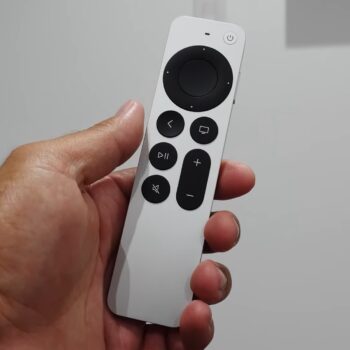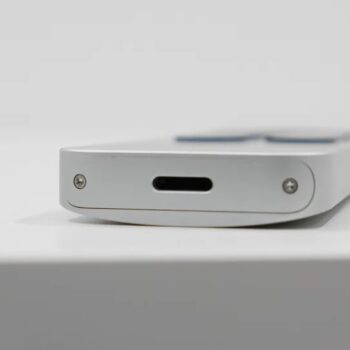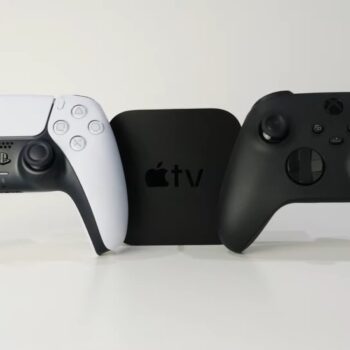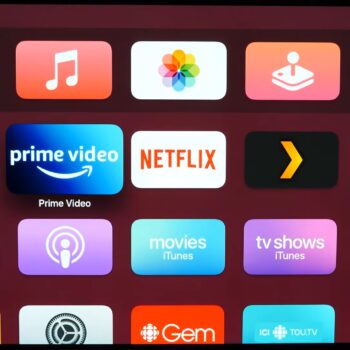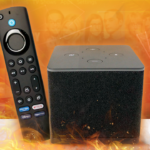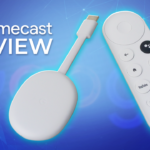In this video, I’ll be reviewing the Apple TV 4K second-generation device.
Right off the bat, I want to point out that this device is incredibly overpriced. Pricing is as follows:
- 32GB: $229 (CAD) or $179 (USD)
- 64GB: $249 (CAD) or $199 (USD)
Now you’ll see throughout this review that this is a pretty solid media player but at this price point, it has a number of shortcomings. I’ll also recommend an alternative media player option near the same price but later in this review. Want to know the most annoying thing about this media player’s price tag? It doesn’t even come with an HDMI cable in the box…
Remote
Let’s go over what is arguably the biggest talking point across the internet, the remote. The original remote for the previous model was terrible. It had gesture controls that would inaccurately go all over the place. Apple listened to the criticism and made the remote simplified. It’s not the most comfortable remote as it’s a little heavier than it needs to be due to the recycled aluminum casing but not a big deal. It’s small enough so reaching for the buttons is easy with one hand.
One thing that had me concerned was the center of the navigation controls which is also a touch-based sensor, which is annoying as I accidentally select the wrong thing often. Thankfully this gesture control can be disabled in the options menu. You can swivel the navigation control to fast forward and rewind video content (if the app you’re using is compatible with that function). For those that notice there isn’t a home button, that’s okay because simply pressing and holding the back button will go to the home screen. On the far right is the dedicated Siri button.
When it comes to powering the remote, I’m pleased to say that it has a built-in rechargeable battery. It requires a lighting cable, one is included in the box (sadly, this should have been USB-C instead). Unfortunately, the media player doesn’t have a USB port and there’s no power brick in the box which means you’ll have to use something else. For Android users, in particular, those that have a quick charging brick, be careful about using your quick charger as you don’t want to risk damaging the remote battery. I’ve been testing this media player for a couple of weeks and have only had the battery go down about 2% which is pretty impressive.
If your TV is compatible, you can use the remote to turn off the TV or control your TV volume. For some reason, the remote can’t turn my TV on though even though it has an IR blaster built in to potentially control your TV and other home theatre devices. The remote also has Bluetooth 5.0.
You can use your iPhone or iPad as a remote since more recent versions of iOS and iPadOS have it built into the Control Center. The functions are basic but work okay. Sadly, there is no remote app from Apple for an Android device. For Android, there are some developed by third-party developers but they’re not guaranteed to work well and they often have mediocre ratings.
Hardware
The media device is pretty small at 3.9 x 3.9 x 1.4” and actually looks like a tiny darker Mac Mini. Underneath it looks like it has soft padding to prevent scratches on a delicate shelf surface but it’s not soft at all (place it gently on delicate surfaces). Underneath is also where ventilation is.
On the back is a port for power, HDMI 2.1 port, and a Gigabit Ethernet port. I’m quite happy that it supports a Gigabit connection as that’s pretty rare in for a media player. On top of that, Apple has placed a WiFi 6 adapter instead of the typical WiFi 5 found in other media players too. Apple has basically future-proofed connectivity in this media player.
The media player also supports Bluetooth 5.0 which means you can connect other devices such as a PS5 Dualsense and Xbox Series X controller to this device (clicking the link will take you to a post showing how to connect each controller). You can also connect a Bluetooth keyboard, mouse, and a Bluetooth headset for private listening. In fact, with AirPods, you can connect two sets of them for private listening.
Interestingly, the media player supports Thread wireless technology. Thread is basically a wireless technology primarily geared at smart home devices to connect with one another without needing a “middle man” service such as IFTTT to allow them to communicate with each other. Thread is also found in the Nest Hub 2 smart display that I recently reviewed. However, as of this review Thread in the Hub 2 and Apple TV doesn’t do anything.
At this price, I’m quite disappointed there’s no USB port to charge the remote or even connect external storage to watch your own media content.
The internal storage is primarily reserved for the operating system and apps. I tried researching ways to copy my own files to the internal storage of the Apple TV but all results on the internet and even on Reddit forums suggest people use media player apps to connect to their own server to sync with VLC or Plex. However, that method only streams media content over your local network, there is currently no method to copy files to the internal storage of the Apple TV. The fact that Apple doesn’t easily allow such a simple media player function with such a heavy price tag is kind of a slap in the face.
Powering the performance is an A12 Bionic processor, the same one found in the 2018 model iPhones. Even though that’s 3 years old, it’s still incredibly powerful for a media player.
The media player and remote only come in the colours I show in this post.
Apple doesn’t list how much power this device consumes. The power cord is six feet long.
Some notable audio functions that this device supports are Dolby Digital 5.1, Dolby Digital Plus 7.1 surround sound Dolby Atmos, and Apple Lossless. Video support features 4K HDR in 60fps, HDR10, Dolby Vision, and HLG.
The quality of video playback from original HDR content from apps such as Apple TV, Disney+, and Netflix (as some examples) is incredibly sharp and crisp. The picture quality will also be dependent on your TV.
Software
Let’s switch over to the software which is powered by tvOS. The interface is simple and incredibly easy to navigate (just like an iPhone) unfortunately, this works against the media player as the interface is incredibly dull and boring (just like an iPhone). Competitor media players will show apps just like Apple TV but have additional rows to suggest other TV shows or movies you might be interested in based on your watching preferences.
You can rearrange the icons in any order though, but that’s the limit in terms of interface customization.
One major plus is the speed of this media player. Opening apps such as Disney+, Prime Video, Netflix, etc. is almost instant. I cannot stress enough how fast this media player is, it’s one of (if not) the fastest media player on the market right now. I dare say, even faster than the 3rd generation Nvidia Shield.
One thing I noticed across the internet is the issue with HDR and SDR playback. People have complained that the media player switches between the two standards on its own and for no reason. So HDR content plays back in SDR for some reason. I personally haven’t encountered this issue (same with many others on the internet too). It seems to only affect a handful of people. I have my Apple TV connected to an LG C9 OLED TV.
It’s possible to add profiles so items on the screen are customized for different family members. The annoying thing about this feature is that each profile requires an Apple account. You can’t simply just create a profile on a device like Fire TV OS, for example.
Perhaps the most interesting app in terms of performance is Plex. The app can play 1080p and 4K content in H.264 and H.265 in mkv and mp4 file format. The exception to this is the large 4K files that I have in mp4 with H.264 compression, the files playback at a large 150Mbps but it stutters. I highly doubt it’s a network bottleneck issue as the device has a WiFi 6 card and 1Gb Ethernet adapter. It seems as though the software design of Plex for this media player isn’t the best, so the app itself is most likely the bottleneck. Especially considering I have some other files in slightly lower playback bitrate that also stutter.
The best performing media player for Plex playback so far is the Nvidia Shield (3rd gen).
In terms of gaming, if you have an Apple Arcade account then this device does a pretty good job at playing games (especially with a paired controller). You could also simply install games from the App Store. The processor does a decent job at running games and they tend to operate rather smoothly.
The Siri smart assistant is available so you can use it to control smart home lighting such as Philips Hue bulbs, search for media content such as “Ted Lasso” or open an app by saying, “Open Netflix”. While Siri might not be considered the best smart assistant, in my testing for these simple types of commands it did everything at lighting speed and put Google Assistant speed to shame.
Mirroring your iPhone/iPad screen is possible but is just a gimmick. The screen mirroring works well and there’s about a second delay between what changes on the mobile device and what’s mirrored.
Airplay is rather disappointing. It can play content from your iPhone/iPad but the quality playback is rather terrible and I don’t recommend using it.
You can use an iPhone to automatically calibrate your screen but I noticed it makes the colour look a bit cold (a bit more blueish grey), I don’t recommend using this method. I tested this on an LED and OLED screen, it seems more like a gimmick.
Score:
7.5/10
Pros:
-Compact remote
-Turn off remote gesture control
-Rechargeable remote
-Remote IR blaster
-Use iPhone/iPad as remote
-Compact body
-Sleek design
-Ethernet 1Gb port
-WiFi 6
-Connect gaming controllers
-Bluetooth private listening
-AirPlay
-Fast performance!
-Easy to use interface
-App store
-Most popular streaming apps
-Dolby Digital 5.1 and 7.1, Dolby Atmos, and Apple Lossless
-Great video playback
-4K HDR in 60fps, HDR10, Dolby Vision, HLG
-Siri control
-Mirror iPhone/iPad screen
Cons:
-Price
-Light cable for remote charging
-No USB port
-Remote IR blaster, not great device compatibility
-No Android remote app
-Boring dated interface
-No HDMI cable
-Can’t connect external storage


